Brisca (also sometimes called Briscas) is a trick taking game of Spanish origin. The game appears to be a direct ancestor of Briscola and is widely played in many Spanish speaking countries on both sides of the Atlantic. The game is thus equally popular in areas such as Puerto Rico, Argentina, Spain and other nearby areas. Brisca is traditionally played using the 40 card Spanish deck. This Spanish deck consists of four suits (gold coins, glasses, swords, and sticks) with these suits containing one card in each of the following denominations; Ace (one), 2, 3, 4, 5, 6, 7, Sota (Jack), Caballo (Horse or Knight), and Rey (King). The ranking of these cards during the play of the game is as follows (from highest to lowest): Ace, 3, King, Caballo, Jack, 7, 6, 5, 4, 2.
If this special Spanish deck is not at hand, however, a standard 52 card French suited deck can be used, in which all cards of denominations 8, 9, and 10 have been removed, thus leaving a 40 card deck. In using this standard deck, the Caballos would be replaced with the Queens, the Sotas the Jacks, and the Reys the Kings. Like it's ancestor, Briscola, Brisca is played by four players in two partnerships consisting of two players each.

Determination of partnerships and first dealer for play of Brisca can be performed using a number of methods, with a draw for high cards a common method. Using this method, each player would draw a card from the face-down pre-shuffled pack. The players drawing the two highest cards form one team in opposition to the players drawing the two lowest cards. The player drawing the highest card of all would be set as the first dealer and also has the first choice of seats at the table. If multiple players draw a card of the same denomination, those cards should be discard and a replacement card drawn. Each player should sit at the table directly across from his partner. After each hand, the role of dealer rotates in a counter-clockwise direction around the table.
Once the players are seated and the dealer determined, the designated dealer thoroughly shuffles the deck and offers it to the player at his left for the cut. After the cut, the dealer then begins dealing the cards, one-by-one and face down, starting with the player at his right. He continues dealing in a counter-clockwise direction around the table until each player has a total of three cards. He then exposes the next card from the remaining stock, places it face up on the table and places the remainder of the deck in a face-down pile partially covering this card. The suit of the exposed thus sets the trump suit to be used for the current hand.
The player to the immediate right of the dealer leads the first card to the first trick and each other player, in a counterclockwise direction around the table in turn, plays a card from their hand to that same trick. A player may play any card still remaining in his hand to the trick, with no restrictions on the suit or denomination of card that must be played.
After each player has played one card to the trick, it is determined which player has won that trick. The player of the highest card in the trump suit played to the trick (if the trick contains any such cards) is considered the winner of the trick. If the trick contains no cards of the trump suit, the trick is won by the highest card of the suit of the first card played to that trick. The winner of each trick will play the first card to the next trick.
The cards won in each trick should be set aside by each partnership, out of play, for later review during scoring for the hand. After each trick has been won, each player then draws one card from the face-down stock. The winner of the trick is the first player to thus draw the top card from the stock, and each other player in a counter-clockwise direction around the table likewise draws one card. The very last card drawn from the stock will be the current exposed trump designator card. Once the stock has been completely exhausted, the players no longer draw cards, playing out the hand using the remaining cards in the hands.
If a player finds that he has the seven of the trump suit in hand, he may exchange that card for the exposed trump suit designator card during play, providing that the trump designator card is any point scoring card (Ace, 3, King, Queen, Jack). In order to so exchange, however, that player must have previously won at least one trick during the current hand. Similarly, if the exposed trump designator card is of denomination 4, 5, 6, or 7, a player holding the two of that same suit may exchange that card for the exposed trump designator card. However, the player making the exchange also has the requirement that they have won at least one trick during the current hand.
There should be enough cards for the play of ten total tricks. After all these tricks have been played and won, each partnership combines all the cards won in tricks and calculates the score for the hand. The scoring for the cards is as per the following chart:
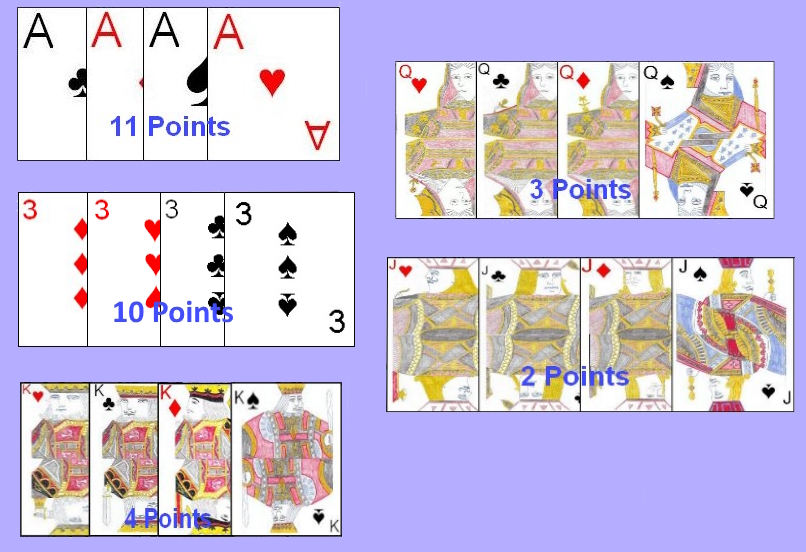
| |
| Card | Point Value |
|---|
| Ace | 11 Points Each |
| 3 | 10 Points Each |
| King | 4 Points Each |
| Queen | 3 Points Each |
| Jack | 2 Points Each |
| 7, 6, 5, 4, 2 | 0 Points |
|
Using the values from this table, whichever partnership has captured a higher total of points during the hand is declared the game winner and scores 1 Game Point. If both teams score exactly 60 points (there are 120 total available points in the deck), the game is a tie and neither team wins that game.
The game session is usually played over the course of multiple hands, and the team which reaches a pre-determined Game Point score (such as 3, 5, or 7) is declared the entire game winner.
As in other games of the Tute and Briscola family, signaling amongst partners is usually allowed
in this game. The following are some of the most usually accepted signals used in Brisca:
| Holding | Indicator Signal |
|---|
| Ace of trump suit | Raise eyes |
| Three of trump suit | Briefly close one eye |
| King of trump suit | Purse the lips |
| Knight of trump suit | Scowl to the right |
| Jack of trump suit | Show tip of tongue |
| Having the Ace and Three in a specific non-trump suit | Turn head briefly to one side |
| Having no cards in trump suit | Close eyes for a moment |
| Requesting partner to play a card not of the trump suit | Motion with the lips as if blowing out a birthday candle |
| Requesting information from partner regarding the cards held | Stare directly at partner for a moment |
Mexican Brisca: Mexican Brisca is played identically to standard Brisca, with one key difference. If one partnership manages to win 11 or fewer total card points during a hand, that team is automatically set as the winner,
of the game regardless of the score of the opposing team.
Hunt the Three: Hunt the Three is a variant of Brisca played in Cuba, which also features an additional way to win the hand outright, regardless of the number of points scored by either team. In this variant if any player manages to capture the three of the trump suit during any trick, using the Ace of the trump suit, the team consisting of the player who captured the three is instantly declared the winner of that game (earning 1 Game Point as normal). However, there is also a restriction on when the Ace of the trump suit can be played to a trick. This Ace can only be played in two circumstances; either if the three of the trump suit has already been played (either to the current trick or a prior trick) by any player, or on the very last trick of the hand. If the player having the Ace of the trump suit does not thus manage to capture the three of the trump suit, the points are calculated as normal based on the cards captured in tricks, and the team with the higher number of captured points is declared the winner of the game.
Bisca de Três: Bisca is a Portuguese
game which is played very similarly to Brisca. The game is commonly
played in both Portugal and also Brazil, particularly due to it's large
Portuguese population. It is usually played using a 40 card deck, which
is thus formed from a standard deck by removing all cards of denominations 8, 9, and 10. The ranking of the cards used for this game is as follows (from highest to lowest): Ace, 7, King, Jack, Queen, 6, 5, 4, 3, 2. Bisca can be played my differing numbers of players, with the following rules describing the game for two players (Bisca de Três). However, please see below for the versions of the game for 4 and 6 players.
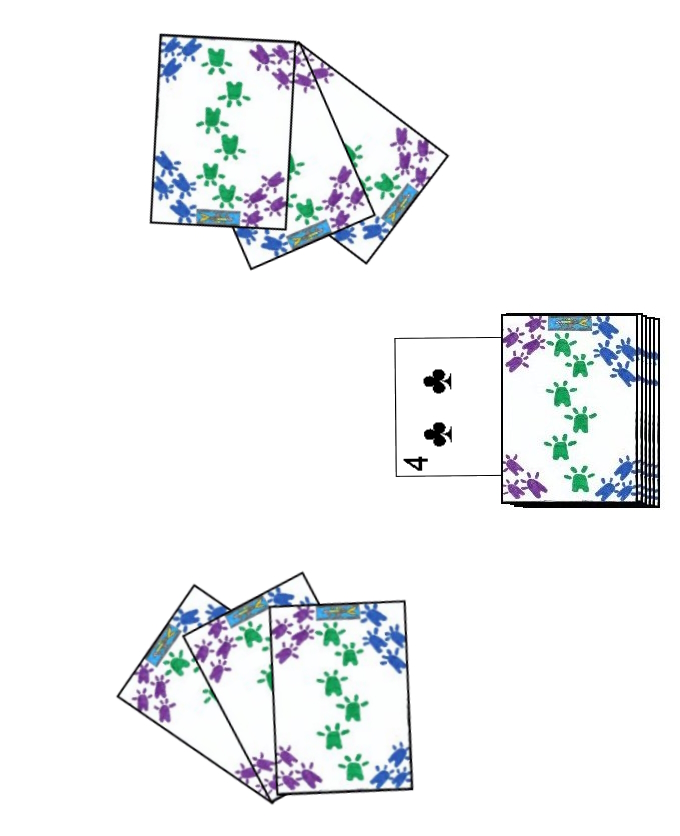
Determination of seating positions and first dealer can be performed in a variety of ways, with draw for a high card a method commonly used. Using that method both players would thus draw a card from the shuffled deck, with the player drawing the highest ranking card taking the first seat of choice, and his opponent then taking the remaining seat at the table. If both players draw cards of the same denomination, they would then discard the previously drawn card and draw another card, continuing until drawing cards of different denominations. The player drawing the highest ranked card is also set as the first dealer.
Once the players are seated, the dealer then shuffles the deck and offers it to his opponent for the cut. After the cut, the dealer then deals his opponent three face-down cards and then three such cards to himself. He then exposes the next card from the deck and places it face up on the table, with this card, and all other cards of that same suit being set as the trump suit for the hand. The dealer then places the remainder of the stack face-down on the table, partially covering the exposed trump card.
The dealer's opponent leads the first card to the first trick and his opponent then plays a card from his own hand to complete the trick. Each player can play any card of choice still remaining in his hand to each trick, with no restrictions based on the suit or denomination of the card led to that trick.
After both players have played one card to the trick, it is determined who has won that trick. If the trick contains any cards in the trump suit for that hand, the player of the highest such card wins the trick. if the trick contains no cards in the trump suit, the player of the highest card of the suit originally led to that trick wins the trick instead. The winner of each trick leads the first card to the next trick.
Each player should keep a face-down pile of the cards won in tricks, to be used at the end of the hand for scoring. The winner of the trick then draws the top card from the remaining in the stock, and his opponent takes the next card, both players adding the card to their current hand. The trump designator card will be the last card drawn. After the stock is exhausted the players finish out the hand using the cards remaining in their hands.
After all the tricks have been played and won, both players sort through their won tricks and accumulate a number of card points based on the value of these captured cards, as per the following chart:
| Card | Point Value |
|---|
| Ace | 11 |
| 7 (Called Bisca) | 10 |
| King | 4 |
| Jack | 3 |
| Queen | 2 |
| 6, 5, 4, 3, 2 | 0 |
|
|
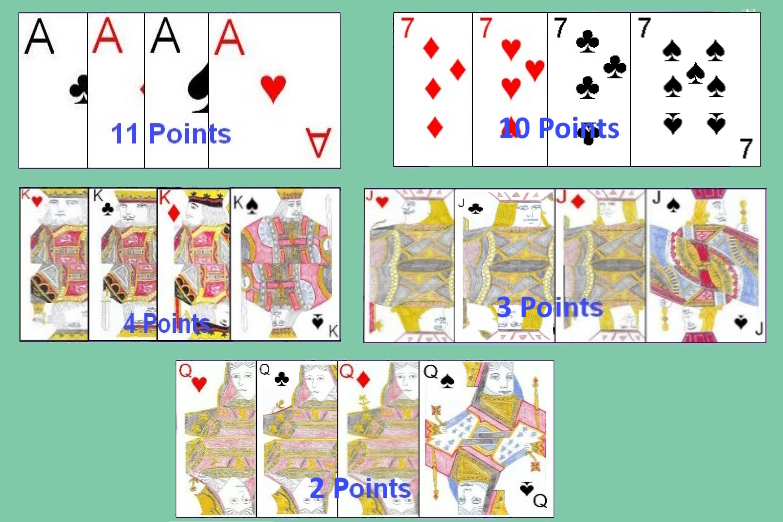 |
Whichever player manages to earn 61 or more points (more than half the available points in the deck) is declared the winner. If both players capture exactly 60 points, there is no winner for that game. Usually a total of ten games is played, with the player winning the majority of these ten games declared the overall winner. The role of dealer alternates amongst the two players after each hand.
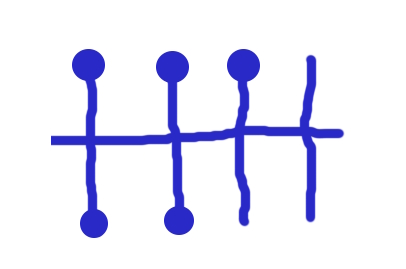
Scoring in the game of Bisca is usually recorded on paper, using a grid like structure (called a comb). This comb consists of one long horizontal line intersected by 10 shorter, vertical lines. One player is assigned the upper half of the vertical lines and the other player the bottom half. Each time the first player wins, he adds a dot or blob at the top of one of the vertical lines, and each time the opponent wins, he adds a dot instead on the bottom of one of the vertical lines. After ten games have been played, the player with the most blobs on his corresponding half of the diagram is the winner.
Bisca de Quatro: Bisca de Quatro is a four player variant of the Portuguese game Bisca. It is played similarly to Bisca de Três, however, Bisca de Quatro is designed for four players, playing in two partnerships of two players each. Each player should sit directly across the table from his partner. The cards won by both partners are then combined at the end of each hand to determine the total points earned by each partnership.
After each trick has been played and won, the winner of said trick draws the top card from the stock (if any cards remain) and then each other player, in a counter-clockwise direction in turn, draws the top card from the stock, adding the card drawn into the hand.
If both teams earn exactly 60 points, there is no winner for that game, and neither team wins any Game Points. If one team manages to win anywhere from 61 to 90 points (inclusive), the team doing so earns 1 Game Point. If a team manages to earn 91 or more points during the hand, that team earns 2 Game Points, unless that team managed to win every trick during the hand, in which they win 4 Game Points instead. It is common to use the same scoring mechanism for Bisca del Quatro as in Bisca del Três.
As in Brisca and in similar games, it is common and accepted for partners to attempt to signal to the other player certain things about their hand to assist in determining the best
strategy for gameplay. The following are the accepted signals (which should be clearly understood by all four players) in Bisca de Quatro:
- Having the Ace of the trump suit - Wrinkle the forehead by opening both eyes very wide
- Having the Bisca (seven of the trump suit) - Briefly close one eye
- Having the King of the trump suit - Make a facial expression with only the right half of the face, using the cheek
- Having the Jack of the trump suit - Make a facial expression using the left half of the face, primarily using the cheek
- Having the Queen of the trump suit - Briefly show the tip of one's tongue
- Having a smaller card in the trump suit - Make a brief kissing motion
- Having a high card (Usually Ace or 7) in a non-trump suit - Briefly bite the lower lip
Other than these few differences, Bisca de Quatro is played identically to Brisca de Três.
Bisca de Seis: Bisca de Seis is a variant of Bisca designed for play by six players. It is played the same as Bisca de Quatro, with a few differences to
accommodate the additional number of players:
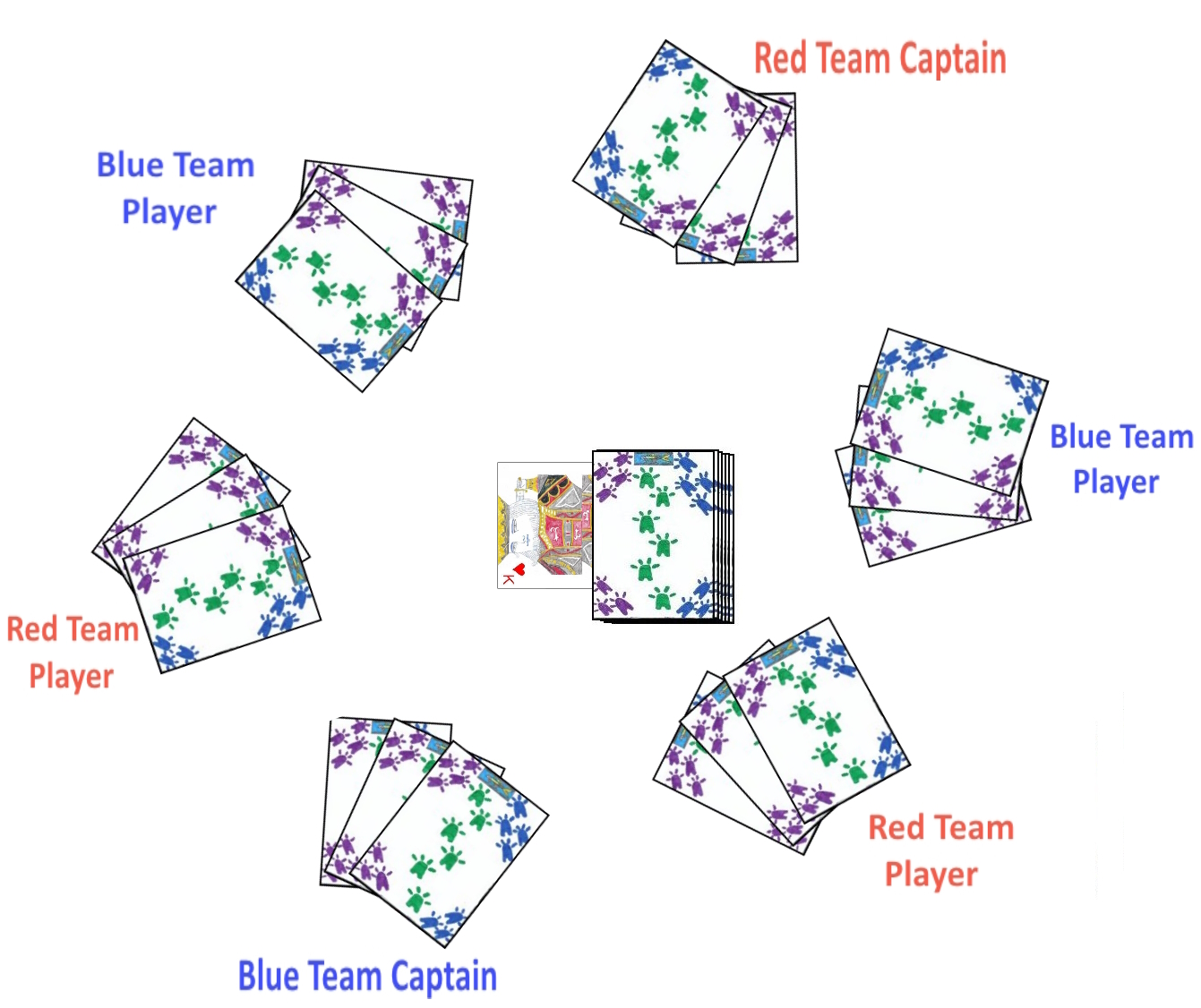
- All cards of denomination two are removed from the deck, leaving a deck consisting of 36 total cards.
- The players are divided into two teams consisting of three players each. Each player should sit at the table such that an opponent from the other team is sitting directly at either side of the player.
- If both teams manage to capture exactly 60 points, there is no winner for that game. If one team manages to win anywhere from 61 to 90 points (inclusive), the team doing so earns 1 Game Point. If a team manages to earn 91 or more points during the hand, that team earns 2 Game Points, unless that team also managed to win every trick during this hand, in which they win 4 Game Points instead.
- After each trick, as long as their are cards remaining in the deck, the winner of each trick draws the top card from the stock, and each other player, in a clockwise direction around the table in turn, then also draws the top card of the stock, adding the card to their hand.
- As in other games of this type, it is common in Bisca de Seis, for players on a team to attempt to communicate, through signals to other players on the same team. However, in this game, one player on each team is usually designated, by that team, as the team captain (with the captain of each team sitting directly across the table from the captain of the opposing team). The players then attempt to communicate signals back and forth to the team captain regarding cards in hand or requests by the
team captain of the specific cards a player has in the hand. The signals used are usually the same as in the four player variant.
Copyright © 2015
CatsAtCards.com. All rights reserved.


 Determination of seating positions and first dealer can be performed in a variety of ways, with draw for a high card a method commonly used. Using that method both players would thus draw a card from the shuffled deck, with the player drawing the highest ranking card taking the first seat of choice, and his opponent then taking the remaining seat at the table. If both players draw cards of the same denomination, they would then discard the previously drawn card and draw another card, continuing until drawing cards of different denominations. The player drawing the highest ranked card is also set as the first dealer.
Determination of seating positions and first dealer can be performed in a variety of ways, with draw for a high card a method commonly used. Using that method both players would thus draw a card from the shuffled deck, with the player drawing the highest ranking card taking the first seat of choice, and his opponent then taking the remaining seat at the table. If both players draw cards of the same denomination, they would then discard the previously drawn card and draw another card, continuing until drawing cards of different denominations. The player drawing the highest ranked card is also set as the first dealer.

 Scoring in the game of Bisca is usually recorded on paper, using a grid like structure (called a comb). This comb consists of one long horizontal line intersected by 10 shorter, vertical lines. One player is assigned the upper half of the vertical lines and the other player the bottom half. Each time the first player wins, he adds a dot or blob at the top of one of the vertical lines, and each time the opponent wins, he adds a dot instead on the bottom of one of the vertical lines. After ten games have been played, the player with the most blobs on his corresponding half of the diagram is the winner.
Scoring in the game of Bisca is usually recorded on paper, using a grid like structure (called a comb). This comb consists of one long horizontal line intersected by 10 shorter, vertical lines. One player is assigned the upper half of the vertical lines and the other player the bottom half. Each time the first player wins, he adds a dot or blob at the top of one of the vertical lines, and each time the opponent wins, he adds a dot instead on the bottom of one of the vertical lines. After ten games have been played, the player with the most blobs on his corresponding half of the diagram is the winner.
